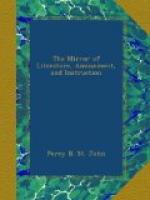3. Irimotu—a rich cane, but does not grow to a large size.
4. Patu—a good cane, of a red colour.
5. To-ura—a dark-striped cane, hard and good.
6. Toute—a bad cane, of a red colour.
7. Veu—a good cane.
8. Vaihi—this attains a large size, and is considered of the best quality. It is said by the natives to have been introduced from the Sandwich Islands.
At Manilla (Island of Luconia) the planters mention three cultivated varieties of the sugar cane:—
1. Cana negra—black sugar cane.
2. " morada—brown "
3. " blancha—white "
of which the black or cana negra is considered the best, from its strength and the quantity of syrup contained in it.
Mr. G.B.’s MS. Journal, 1829-30.
* * * * *
THE BARN OWL;
and the Benefits it confers on Man. By Charles Waterton, Esq.
This pretty aerial wanderer of the night often comes into my room; and after flitting to and fro, on wing so soft and silent that he is scarcely heard, he takes his departure from the same window at which he had entered.
I own I have a great liking for this bird; and I have offered it hospitality and protection on account of its persecutions, and for its many services to me,—I say services, as you will see in the sequel. I wish that any little thing I could write or say might cause it to stand better with the world at large than it has hitherto done: but I have slender hopes on this score; because old and deep-rooted prejudices are seldom overcome; and when I look back into the annals of remote antiquity, I see too clearly that defamation has done its worst to ruin the whole family, in all its branches, of this poor, harmless, useful friend of mine.
Ovid, nearly two thousand years ago, was extremely severe against the owl. In his Metamorphoses he says:—
“Foedaque fit volucris, venturi
nuncia luctus,
Ignavus bubo, dirum mortalibus omen."[1]
In his Fasti he openly accuses it of felony:—
“Nocte volant, puerosque petunt nutricis egentes."[2]
Lucan, too, has hit it hard:—
“Et laetae juranter aves, bubone sinistro:"[3]
and the Englishman who continued the Pharsalia, says—
“Tristia mille locis Stylus dedit omina bubo."[4]
Horace tells us that the old witch Canidia used part of the plumage of the owl in her dealings with the devil:—
“Plumamque nocturnae strigis."[5]
Virgil, in fine, joined in the hue and cry against this injured family:—
“Solaque culminibus ferali carmine
bubo Saepe queri, et longas in fletum
ducere voces."[6]
In our own times we find that the village maid cannot return home from seeing her dying swain, without a doleful salutation from the owl:—




